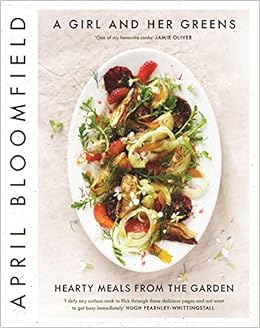 Reviewed by Magdalena Ball
Reviewed by Magdalena Ball
A Girl and her Greens
By April Bloomfield
A&U Canongate
27 May 2015, ISBN: 9781782111702, hardcover, $49.99
Let me begin this review by saying how beautiful this book is. If you’re not keen on cooking, you could just put it on the coffee table, and gawk from time to time at the exquisite photos by award-winning photographer David Loftus, the sweet, clever cartoons by Sun Young Park, or just enjoy Bloomfield’s prose, which will take you to farmer’ markets, through the philosophy of simple pleasures and enjoying the cooking process for its own sake (the journey rather than the destination), insider knowledge on particular ingredients like garlic, herbs, fennel and tomatoes, or the little blurbs of history and context above each recipe. This isn’t a cheap book, but it would make a wonderful gift for someone who loves not just creating food, but reading about, buying and talking about food too. Bloomfield is as good a writer as she is a cook. There are plenty of interesting tidbits, recollections, and ideas for variations at the start of each recipe – something I always look for in a cookbook.
Many of the recipes are quite simple. For example, “Crushed Spring Peas with Mint” is just a bunch of ingredients blended in a food processor. I have to admit, rather shamefully, to making this dish this with frozen peas, but it was still delicious (I know it would be far better with fresh ones but I didn’t have any on hand and had to try it). The salad sandwiches are just big stacked up sandwiches. Greek Salad, Courgette Bread, Focaccia, Hasselback Potatoes, and Potato Soup are all pretty standard fare, but there’s something about the way Bloomfield approaches these foods that ramps them right up. I think it’s mostly because the ingredients are treated with so much love and reverence: “If I could get away with opening a restaurant that served only boiled potatoes with butter and black pepper I just might” (62). Then there are the innovative options like “Lumaconi Stuffed with Summer Vegetables”, the “Roasted Carrots with Carrot-Top Pesto and Burrata”, “Roasted Treviso with Breadcrumbs and Gorgonzola”, or the “Broccoli Raab Morning Buns”: “They’re magic, really – buttery layers of dough that are somehow both rich and delicate, crackly on the outsides and soft in the middle” (160). I haven’t made the morning buns yet (soon…), but the “Corn Pudding” is a delicious sweet dinner option for vegetarians – it holds pretty well too – more like a quiche than a soufflé, and in this case, fresh corn is an absolute must.
Not everything in the book is vegetarian. There are recipes that use bone marrow, bacon, lardons, ground pork, and pancetta, but all of the meat recipes are concentrated into one chapter, humorously titled “a little beast goes a long way”. Though the dishes aren’t really simple home cooking faire as such – you can make them with whatever you’ve got, and there are plenty of ways to modify (something I’m afraid I always do, not always to good effect), but they won’t be sublime unless you procure really high quality fresh vegetables of the sort that, as Bloomfield makes very clear, can only be found in a farmer’s market. That said, if you’re looking for food that is quite accessible both to cook and eat, but still fancy enough to serve to guests, there are lots of options here which will certainly extend the vegetarian repertoire, and will encourage you to experiment more with fresh ingredients like Kale (“Kale Polenta”), or mushrooms (“Morels with Madiera Cream on Toast”). I dare you to read it and not visit your nearest farmer’s market as soon as you can. Until then, you can put Girl and Her Greens on your coffee table or read it like a novel and you still won’t be disappointed.